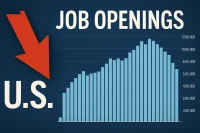Walmart CEO Doug McMillon says many American shoppers are feeling financial pressure, with food prices still higher than before the pandemic.
TT News reports McMillon highlighted how some customers are running out of money before the month ends.
He was speaking to about 1,000 business leaders at the Economic Club of Chicago on February 27.
Many are switching to smaller pack sizes to stretch their budgets, especially toward the end of the month. While prices for products like clothing have returned to pre-pandemic levels, food prices remain elevated.

Inflation Squeezes Household Budgets
Walmart, which ranks No. 1 on the Transport Topics Top 100 list of private carriers in North America, has seen growing signs of financial stress among customers.
McMillon said:
“You can see that the money runs out before the month is gone; you can see that people are buying smaller pack sizes at the end of the month.”
Even as shopping habits have stayed largely stable over the past year, McMillon said consumers are increasingly careful, focusing more on value.
Food Prices Drive Inflation Concerns
January inflation data showed a sharp jump, with food prices leading the way.
According to the US Bureau of Labor Statistics, egg prices surged more than 15% in January alone, the steepest rise since 2015.
Bird flu outbreaks wiped out millions of chickens, pushing egg prices 55% higher than a year earlier.
President Donald Trump even called the situation “a disaster.”
McMillon said Walmart is actively tracking egg prices and working to ease the impact on customers.
While prices for non-food items have dropped, food prices remain stubbornly high. McMillon pointed to factors like:
- Higher wages
- Increased input costs
- Ongoing supply chain challenges
McMillon said:
“There are lots of income levels in this country — if you’re at the lower end of that scale, you are feeling more frustration and pain because of higher food prices.
“They’ve persisted for years now, and you’re just tired of it.”
Hiring? Post jobs for free with WhatJobs
Discount Retailers See Similar Trends
The impact of rising food prices isn’t limited to Walmart. Dollar General, No. 18 on the private TT100 list, also reported that inflation is hurting lower-income shoppers. Many customers are struggling to stretch their income across the whole month, a trend that has worsened over the past year.
US Food Trade Deficit Grows
America’s food imports are expected to exceed exports for the third straight year, with the agriculture trade deficit forecast to hit a record $49 billion in 2025, according to the U.S. Department of Agriculture.
The US historically ran food trade surpluses, but deficits appeared during Trump’s trade war with China and have continued since.
Walmart has long navigated tariffs, thanks to its diverse supply chain, but ongoing global challenges add to pricing pressures.
Walmart’s Chicago Store Closures Reflect Broader Issues
McMillon also addressed Walmart’s decision to close half of its stores in Chicago.
Those locations were already losing money, then suffered extensive damage during the unrest of 2020.
McMillon explained the internal debate Walmart faced:
“Do we reopen them, or, given that they lose money, do we just use this opportunity to say we just decided not to reopen?”
Ultimately, McMillon and other leaders decided to try again and reopen. However, financial losses deepened after reopening, and safety concerns grew.
“On top of that, I started to develop concerns about safety and security,”.
Walmart Focuses on E-Commerce and Store Upgrades
As it faces shifting consumer behavior and economic challenges, Walmart continues to invest heavily in e-commerce. McMillon said Walmart offers more than 700 million items online and is working toward a goal of one billion.
At the same time, Walmart is upgrading its more than 4,600 US stores to make them more modern and easier to shop in. The company is also expanding into areas like:
- Membership programs
- Digital advertising
- New store formats
Need Career Advice? Get employment skills advice at all levels of your career
What’s Next for Walmart and Its Shoppers?
With food inflation still squeezing household budgets, Walmart expects a challenging year ahead.
The company recently projected lower-than-expected profits, partly due to uncertainty around consumer spending.
As prices remain high, especially for essentials like food, Walmart will likely face continued pressure to balance its “everyday low prices” promise with rising costs.
For lower-income shoppers, who rely heavily on retailers like Walmart, every price increase adds to the strain.
McMillon’s message was clear: budget-conscious customers are struggling, and Walmart is keeping a close watch on how to support them — even as the economic landscape remains unpredictable.




